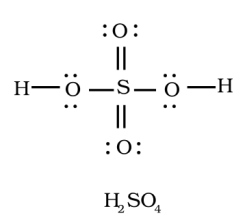
Sulphuric acid provides a simple example of:
(A) Coordinate bonds
(B) Non-covalent compound
(C) Covalent ion
(D) Non-covalent ion
(E) None of these
Answer
425.7k+ views
2 likes
Hint : The elements that are in and beyond the third period of the periodic table have 3d also available for bonding. Sulfuric acid is a compound with covalent bonds, since all the bonds are covalent.
Complete Step By Step Answer:
Sulphur is the central atom in sulphuric acid(

Atomic number of sulphur is
Valency of oxygen is
The total number of electron pairs are determined by dividing the total valence electrons by two.
Sulphuric acid has
The sulphur will form a double bond with oxygen as shown in the above diagram.
The bonding between the atoms is by sharing the electrons.
Therefore, sulfuric acid is a compound with covalent, since all the bonds are covalent.
But Sulphuric acid is a very strong acid, it completely ionizes into hydronium(
Therefore from the above conclusion we can easily conclude that Sulphuric acid has covalent bonds but it ionizes readily making it a very strong acid.
The option
Note :
Many sites claim Sulphuric acid to have coordinate bonds, which is insignificant to debate currently. The bonds that loosely hold hydrogen are very weak and ionic. Therefore the hydrogen ion is easily separated from the molecular lattice in aqueous solution.
Complete Step By Step Answer:
Sulphur is the central atom in sulphuric acid(

Atomic number of sulphur is
Valency of oxygen is
The total number of electron pairs are determined by dividing the total valence electrons by two.
Sulphuric acid has
The sulphur will form a double bond with oxygen as shown in the above diagram.
The bonding between the atoms is by sharing the electrons.
Therefore, sulfuric acid is a compound with covalent, since all the bonds are covalent.
But Sulphuric acid is a very strong acid, it completely ionizes into hydronium(
Therefore from the above conclusion we can easily conclude that Sulphuric acid has covalent bonds but it ionizes readily making it a very strong acid.
The option
Note :
Many sites claim Sulphuric acid to have coordinate bonds, which is insignificant to debate currently. The bonds that loosely hold hydrogen are very weak and ionic. Therefore the hydrogen ion is easily separated from the molecular lattice in aqueous solution.
Latest Vedantu courses for you
Grade 11 Science PCM | CBSE | SCHOOL | English
CBSE (2025-26)
School Full course for CBSE students
₹41,848 per year
Recently Updated Pages
Master Class 11 Economics: Engaging Questions & Answers for Success

Master Class 11 Business Studies: Engaging Questions & Answers for Success

Master Class 11 Accountancy: Engaging Questions & Answers for Success

Master Class 11 English: Engaging Questions & Answers for Success

Master Class 11 Computer Science: Engaging Questions & Answers for Success

Master Class 11 Maths: Engaging Questions & Answers for Success

Trending doubts
State and prove Bernoullis theorem class 11 physics CBSE

1 ton equals to A 100 kg B 1000 kg C 10 kg D 10000 class 11 physics CBSE

State the laws of reflection of light

One Metric ton is equal to kg A 10000 B 1000 C 100 class 11 physics CBSE

1 Quintal is equal to a 110 kg b 10 kg c 100kg d 1000 class 11 physics CBSE

Difference Between Prokaryotic Cells and Eukaryotic Cells




